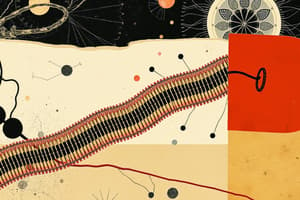Podcast
Questions and Answers
What is the primary characteristic that defines all living things?
What is the primary characteristic that defines all living things?
- The presence of highly-organized structures in their cells, tissues, organs, or organ systems
- Being made of cells (correct)
- The ability to reproduce and pass their genes to their offspring
- The ability to respond to changes in their environment
Which of the following is an example of order in living organisms?
Which of the following is an example of order in living organisms?
- The presence of tiny hair-like structures called cilia covering the entire surface of a paramecium (correct)
- The random arrangement of rocks on a beach
- The changing colors of a sunset
- The unpredictable movement of a tornado
What is the main purpose of adaptations in living organisms?
What is the main purpose of adaptations in living organisms?
- To maintain a specific range of internal conditions
- To increase their energy intake
- To survive and reproduce at higher rates (correct)
- To respond to changes in their environment
What is an example of regulation/homeostasis in living organisms?
What is an example of regulation/homeostasis in living organisms?
Which of the following is NOT an example of reproduction?
Which of the following is NOT an example of reproduction?
What is the primary source of energy for most living organisms?
What is the primary source of energy for most living organisms?
What is the process by which living organisms grow and develop?
What is the process by which living organisms grow and develop?
Which of the following is an example of a response to the environment?
Which of the following is an example of a response to the environment?
Flashcards are hidden until you start studying
Study Notes
Characteristics of Life
- Living organisms are composed of cells, which are the basic structural and functional units of life (e.g., human cheek cells, plant leaf cells, bacteria E. coli cells)
Order
- Living organisms exhibit order, which is reflected in the highly organized structures of their cells, tissues, organs, and organ systems
- Examples of order include the presence of cilia on the surface of a single-celled paramecium and the identical internal order of cilia in a human trachea, as well as the pattern of a sunflower
Adaptations
- In a population, individuals with favorable traits have a higher survival and reproduction rate
- Adaptations can result in modified structures, such as the leaves of a cactus that have evolved into sharp spines to protect the plant from predators
Response to Environment
- Living organisms can respond to changes in their environment, known as stimuli
- Examples of responses to stimuli include a Venus fly trap closing on a fly that triggers the trap and sunflowers moving to face the sun as it travels across the sky
Regulation/Homeostasis
- Living organisms maintain a specific range of internal conditions despite external changes
- Examples of regulation/homeostasis include dogs and chickens panting to cool down when they are too hot
Reproduction
- All living organisms can reproduce, passing their genes (DNA/RNA) to healthy, fertile offspring
- Examples of reproduction include a turtle laying eggs that hatch into baby turtles
Energy Processing
- Living organisms require a source of energy, which can come from photosynthesis or consuming other organisms
- An example of energy processing is a caterpillar eating a leaf to obtain energy
Growth and Development
- Organisms grow and develop in a specific sequence based on the instructions in their genes
- An example of growth and development is a frog egg hatching into a tadpole, which eventually metamorphoses into a frog
Studying That Suits You
Use AI to generate personalized quizzes and flashcards to suit your learning preferences.




